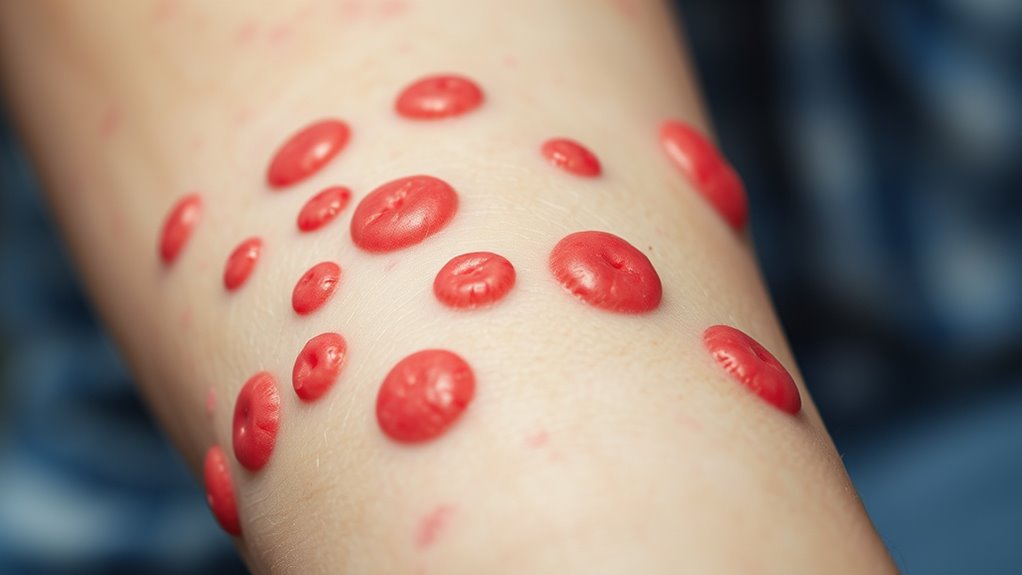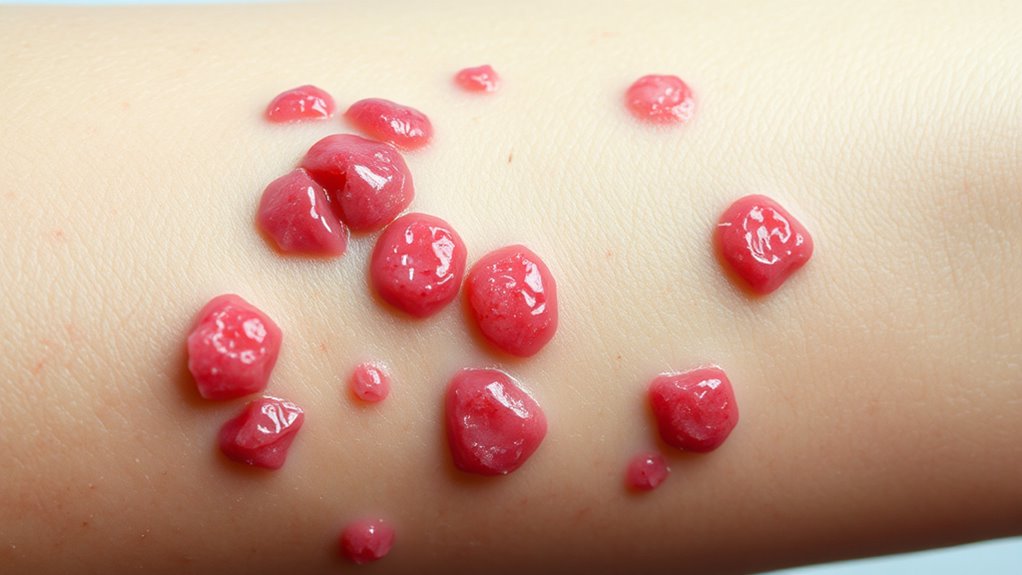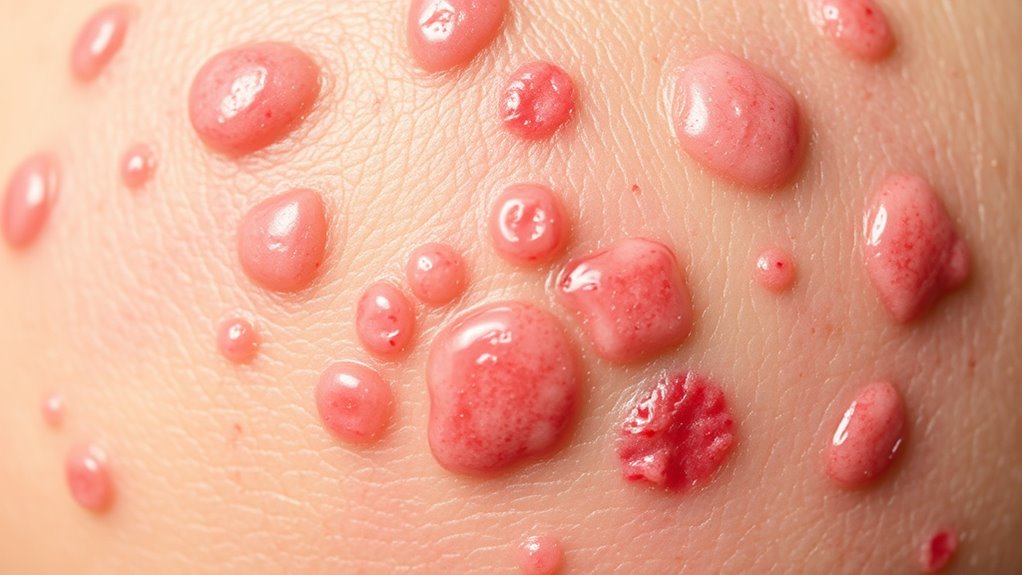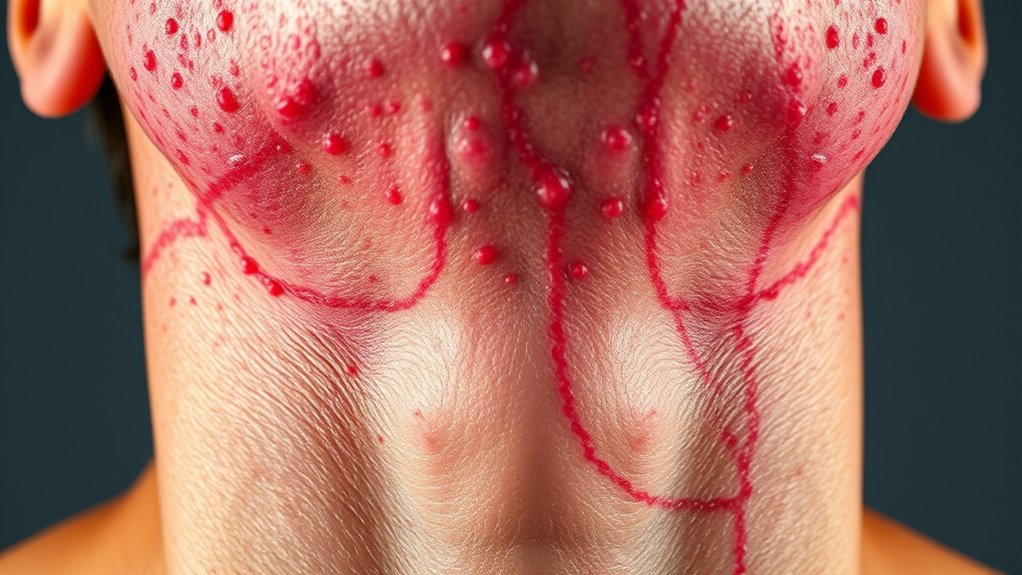Seek emergency help immediately if you experience difficulty breathing, swelling of your face or throat, or a rapid, weak pulse during a hive outbreak. These are signs of a severe allergic reaction that can become life-threatening. Also, watch for persistent or worsening hives, signs of infection, fever, or repeated episodes. Recognizing these symptoms early can make all the difference; continue uncovering important guidance to stay safe and responsive.
Key Takeaways
- Seek emergency help if you experience difficulty breathing, facial or throat swelling, or fainting signs.
- Consult a healthcare provider if hives persist beyond a few days or worsen despite treatment.
- Call emergency services immediately for rapid heartbeat, dizziness, or chest tightness with hives.
- Watch for signs of infection like increased redness, warmth, swelling, or pus around hives.
- Contact a healthcare professional if recurrent hives affect daily life or are associated with other serious symptoms.
Signs of Severe Allergic Reactions

Severe allergic reactions, known as anaphylaxis, require immediate attention because they can escalate quickly and become life-threatening. If you notice difficulty breathing, wheezing, or swelling of your face, lips, or throat, seek help right away. Rapid heartbeat, dizziness, or fainting are signs the reaction is worsening. You might also experience a feeling of dread, confusion, or a sudden drop in blood pressure. Hives may spread quickly, and you could develop a sense of tightness in your chest or a persistent cough. If any of these symptoms appear, call emergency services immediately and use an epinephrine auto-injector if you have one. Acting fast can save your life, so don’t hesitate to get urgent medical help. Monitoring your symptoms is crucial to ensure timely intervention and prevent further complications.
Persistent or Worsening Hives

If your hives persist beyond a few days or continue to worsen despite initial treatment, it’s important to seek medical advice. Persistent hives can indicate an underlying issue that requires professional evaluation. You might notice that the welts are not fading or are spreading, or the itching becomes more intense and disruptive. Worsening symptoms, such as increased swelling or new areas affected, also signal the need for medical attention. Ignoring ongoing hives can lead to complications or mask a more serious condition. A healthcare provider can determine if additional treatments are necessary or if further tests are required to identify underlying causes. Prompt medical care ensures you receive appropriate relief and prevents potential complications.
Signs of Infection or Skin Damage

Watch for signs that your hives might be infected or causing skin damage, as these require prompt attention. Look out for increasing redness, swelling, or warmth around the affected area, which can indicate infection. You might notice pus or oozing, suggesting bacterial involvement. Skin damage signs include open sores, bleeding, or ulceration. If you experience fever, chills, or worsening pain, seek help immediately. The table below highlights key signs to watch:
| Sign | Description | Action Needed |
|---|---|---|
| Increased redness | Spreading or deepening redness | Seek medical advice |
| Pus or oozing | Fluid or pus from the hive | Visit a healthcare provider |
| Fever or chills | Systemic signs indicating infection | Contact your doctor |
| Skin ulceration | Open sore or tissue breakdown | Urgent medical attention |
Prompt recognition helps prevent complications. Infection signs can develop rapidly and require swift medical intervention.
Symptoms Accompanying Hives

When hives appear, they often come with other symptoms that can help you identify their cause or severity. You might notice swelling in your lips, face, or throat, which signals a more serious reaction. It’s common to experience itching, burning, or stinging sensations around the hive areas. Some people feel dizziness, lightheadedness, or nausea, indicating a potential allergic response that requires prompt attention. If you develop difficulty breathing, wheezing, or chest tightness along with hives, these are signs of a severe allergic reaction. Additionally, fever or feeling generally unwell can suggest an underlying infection. Pay close attention to these accompanying symptoms, as they guide whether you can manage the hives at home or need urgent medical help. Recognizing trust issues or patterns of recurring problems can also be crucial in understanding the underlying cause of your symptoms.
Recurrent Episodes of Hives

If you experience hives repeatedly, paying attention to how often they occur and how severe your symptoms are is important. Recurrent episodes can disrupt your daily routine and signal a need for medical advice. Understanding these patterns helps determine when it’s time to seek professional help. Recognizing the distinctive features of different conditions can aid in proper diagnosis and treatment.
Frequency of Episodes
Frequent episodes of hives can be a sign that your condition needs closer attention. If you notice recurring outbreaks happening several times a week or month, it’s important to track their frequency. Consistent episodes may indicate an underlying allergy or other health issue that requires medical evaluation. Keep a diary of when hives appear, how long they last, and any triggers you observe. This information helps your healthcare provider determine if your hives are episodic or persistent, and whether they need further testing or treatment. While occasional outbreaks are common, frequent episodes that disrupt your daily life suggest you should seek professional advice. Addressing the frequency early can prevent complications and improve your overall management of the condition. Monitoring skin reactions and their patterns can provide additional insights into potential triggers or underlying causes.
Severity of Symptoms
Recurrent episodes of hives can vary widely in severity, ranging from mild discomfort to intense, widespread swelling. You might notice small, itchy bumps that fade quickly or large welts that cause significant pain and tightness. Sometimes, your hives may stay localized, while other times, they spread across multiple areas, making you feel overwhelmed. Severe reactions can include swelling of the lips, tongue, or throat, which may interfere with breathing or swallowing. If your symptoms escalate to this level or persist longer than 24 hours, it’s a sign you should seek medical help immediately. Even if symptoms are mild but recurrent, monitoring their pattern helps determine if professional evaluation is necessary. Recognizing the severity of your hives is key to managing the condition effectively.
Impact on Daily Life
Living with episodes of hives can considerably disrupt your daily routine, making it hard to focus on work, school, or social activities. Recurrent hives can cause constant discomfort, leading to frustration and fatigue. They may also interfere with your plans, forcing you to cancel or postpone important events. To manage this impact, consider these steps:
- Prioritize rest and avoid triggers that worsen your symptoms.
- Communicate your condition with colleagues or friends to gain support.
- Keep a symptom diary to identify patterns and discuss them with your doctor.
- Understanding hives triggers can empower you to better prevent future episodes and reduce their frequency.
These strategies help you regain control and minimize the disruption caused by recurrent hives, allowing you to better manage your daily life despite the challenges.
Difficulty Breathing or Swelling of the Face and Throat

If you notice difficulty breathing or swelling of your face and throat, it’s a sign that your allergic reaction may be severe and requires immediate attention. These symptoms indicate that your airway could be closing or severely obstructed, which can be life-threatening. Do not wait or try to manage these symptoms at home. Call emergency services right away and seek urgent medical help. While waiting for help, try to stay calm and sit in a comfortable position, but avoid lying flat. If you have an epinephrine auto-injector, use it as directed. Recognizing these signs early is essential to prevent serious complications or death. Always treat breathing difficulties and facial or throat swelling as medical emergencies. Understanding the importance of prompt action can make a critical difference.
Frequently Asked Questions
Can Hives Indicate an Underlying Health Condition?
You might wonder if hives signal a deeper health issue. While most hives are harmless and caused by allergies or irritants, they can sometimes indicate underlying conditions like infections, autoimmune diseases, or reactions to medications. If your hives persist, worsen, or are accompanied by symptoms like difficulty breathing or swelling, you should seek medical advice promptly to rule out serious health concerns.
Are There Specific Foods That Commonly Trigger Hives?
You might wonder if certain foods trigger hives. Common culprits include nuts, shellfish, eggs, dairy, and soy. Food allergies can cause your immune system to react, leading to hives. Keep track of what you eat and note any reactions. If you notice a pattern, avoid those foods. If hives persist or worsen, see a healthcare professional to identify triggers and get appropriate treatment.
How Long Do Hives Typically Last Without Treatment?
Hives usually last about 24 to 48 hours without treatment, but they can sometimes persist longer. If your hives last more than a couple of days or keep coming back, you should see a healthcare professional. Additionally, if they’re accompanied by swelling, difficulty breathing, or dizziness, seek medical help immediately. Prompt treatment can ease your discomfort and prevent complications.
Can Stress Cause or Worsen Hives?
Imagine stress as a storm brewing inside you, stirring up hidden clouds. It can definitely cause or worsen hives, like lightning striking unpredictably. When you’re overwhelmed, your body releases chemicals that trigger these itchy, red bumps. Recognize this connection to manage your stress better, and if hives persist or worsen, seek help. Addressing stress early acts like calming the storm, helping your body find peace and healing.
Is It Safe to Use Over-The-Counter Antihistamines Long-Term?
You wonder if using over-the-counter antihistamines long-term is safe. Generally, they’re safe for short-term use, but prolonged use can lead to side effects like drowsiness or dry mouth. It’s best to consult your doctor if you plan to use them regularly. They can recommend the right type or suggest alternative treatments to manage your symptoms effectively and safely over time.
Conclusion
Think of hives as warning signals from your body’s own fortress, alerting you to hidden threats. When these signals turn loud or unending, it’s like ignoring a fire alarm—danger is near. Don’t wait until the walls are crumbling; seek help promptly. Listening to your body’s alerts keeps your health strong, much like tending to a small flame before it becomes a wildfire. Act now to protect your well-being before it’s too late.








